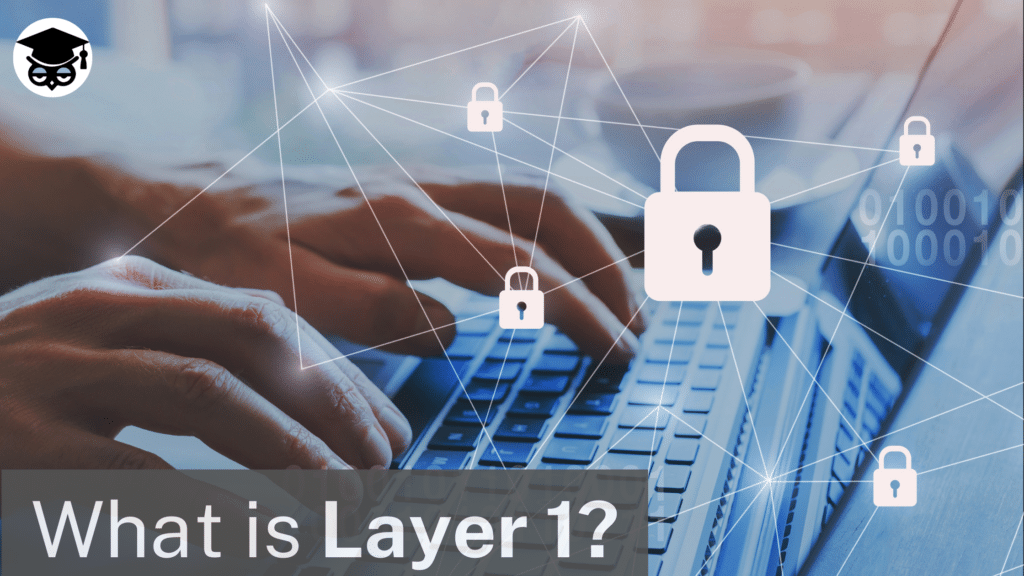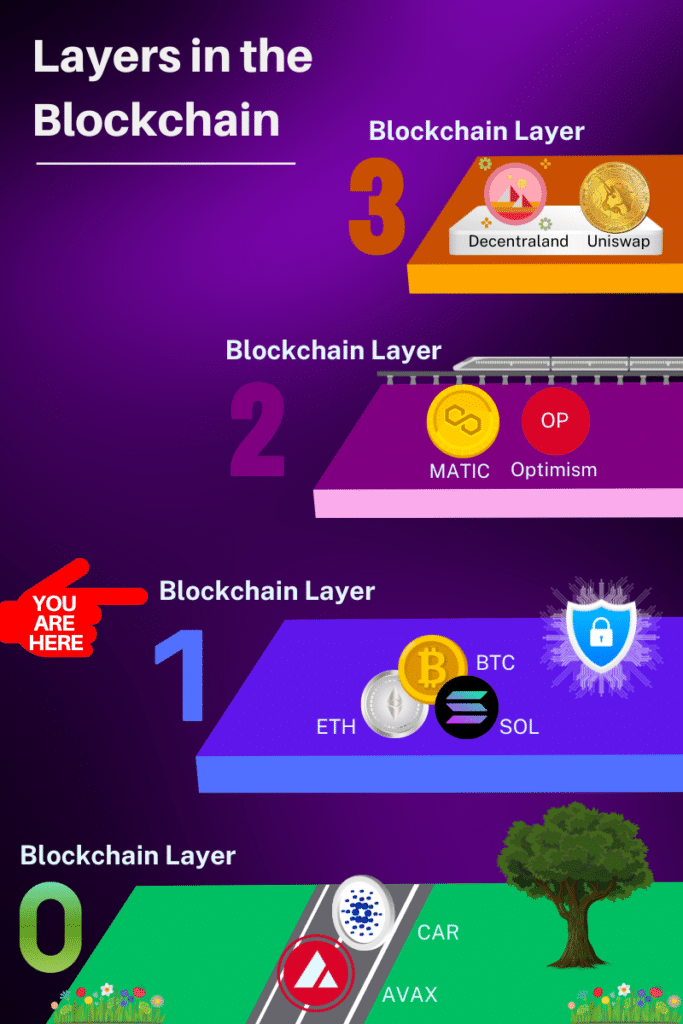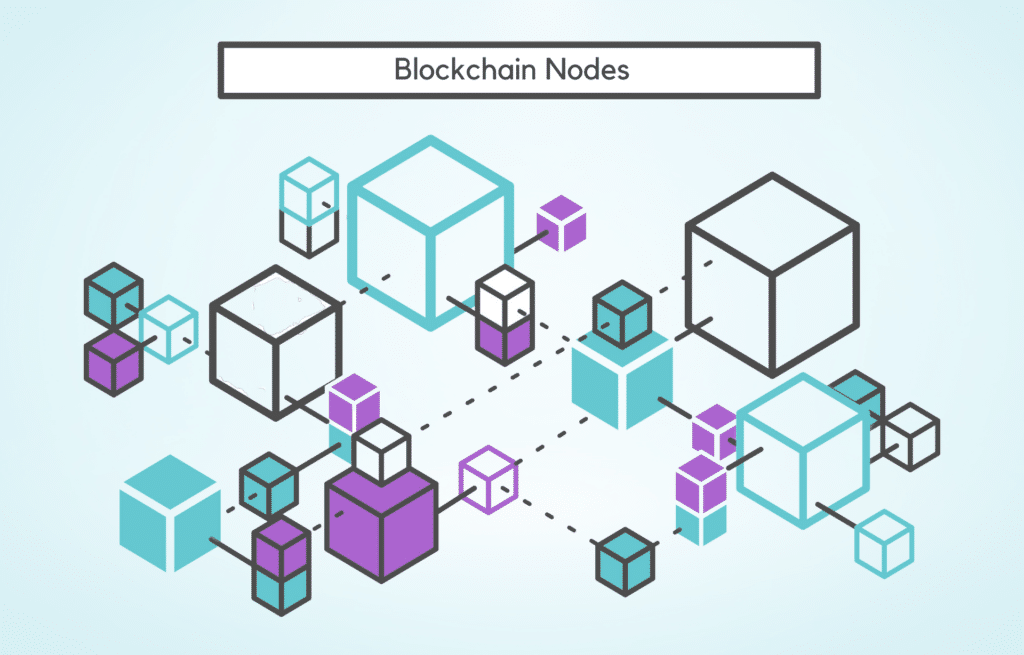What is Layer 1?
In a blockchain project, Layer 1 is the fundamental layer of the blockchain. It houses all the rules of the blockchain, and most blockchain projects only have this layer.
The Long Definition
Over time, blockchains have become more and more complex. With the popularity of cryptocurrency and blockchains, exciting advances have been made in these areas. The different aspects of this complexity are referred to as layers.
In a simple blockchain setup, Layer 1 is the only layer. In a more complex blockchain ecosystem, it is the foundation. This layer is where you’ll find all the code that governs the variables of the blockchain. These variables include things like blockchain security, how miners or validators operate, and how blocks of data are formed.
The previously mentioned ecosystem could also incorporate a Layer 0 that helps the blockchain talk to other blockchains, along with a Layer 2 and a Layer 3 that support other projects like gaming or finances.

Understanding Layer 1
Layer 1 is what most people envision when they think of a blockchain. For most projects, it is the only layer and everything happens there. In a bigger blockchain project, like Ethereum, it is the foundation upon which other layers are built. So, it typically handles crucial functions like processing, finalizing, and recording crypto transactions.
It is also where the consensus mechanism is implemented. The consensus mechanism is the set of rules that tells everyone how transactions are going to be verified. This is crucial to security and decentralization.
A Layer 1 blockchain has its own native token. These tokens are typically used to “grease the wheels” of the blockchain. Not everything on a blockchain is automated, and these tokens are used to pay people transaction fees for doing the work that requires a human touch. Most often, this is validating blocks of data.
A good illustration would be the Ethereum ecosystem. It consists of thousands of decentralized applications (dApps). It is also home to other networks. But while these dApps and chains have their own tokens, all transaction fees are paid in ether (ETH).
Ether is the native cryptocurrency of Ethereum, which is the Layer 1 blockchain in this ecosystem. The other chains are known as Layer 2s. These are networks built on top of the main, Layer 1, chain.

Layer 1 Limitations
A blockchain project will always be faced with a three-sided problem. This is called the blockchain trilemma since there are three core parts that are always fighting with each other.
The Blockchain Trilemma
The three core parts of this problem are scalability, decentralization, and security.
- Scalability: A protocol’s ability to handle a high load of transactions during peak periods. It mainly affects the transaction processing speed. This, in turn, affects the transaction cost. Generally, the more scalable a blockchain is, the faster and cheaper the transactions become.
- Decentralization: Refers to the absence of a central authority. A decentralized system is self-governing. Here, the control and power over the network are more or less equally distributed among the participants.
- Security: This is all about being safe from malicious attackers. A good blockchain network cannot be hacked. It is also safe from double-spending, i.e., using the same coin/token in multiple transactions.
According to the trilemma, a network cannot have one hundred percent security, scalability, and decentralization. Blockchain architecture means that it is a balancing act where the protocol can fully achieve two at best. Having more of one or two means having less of the other(s).
For example, having a high degree of decentralization and security comes at the cost of scalability. Similarly, having more scalability comes at the cost of decentralization and security.
Why is this the case?
Take a blockchain that tries to be highly decentralized. It will have many nodes – computers in the network running the blockchain’s software. The more nodes a network has, the more decentralized it is. A blockchain with 10,000 nodes is more decentralized than one with 5,000 nodes.

It is also more secure. This is because having more participants means that hackers have more computers to aim at. Generally, hackers need to access at least 51% of nodes to take control of a network. This is known as a 51% attack. The more nodes a blockchain has, the more secure it will be from a 51% attack.
However, it also means that there are more nodes to participate in verifying transactions. Therefore, the transaction processing time increases. This leads to slower transaction processing speeds (TPS). So, the network will struggle at times of high transaction loads. That means it is not very scalable.
The other scenario is a blockchain with fewer nodes. This one is able to process transactions faster. However, having fewer nodes means that such a network isn’t very decentralized. This makes it more vulnerable to a 51% attack since hackers have fewer computers to aim at.
Layer 1 blockchains like Ethereum and Bitcoin suffer from the first trilemma. They are very decentralized – Bitcoin with more than 15,000 nodes, and Ethereum with around 4,500. This helps a lot with their security. However, it also means that they’re not very scalable. Therefore, they have low TPS and high fees.
Others, like BNB Chain and Solana, are in the second scenario. They have a relatively lower node count. This gives them a faster TPS, making them more scalable. However, it also makes them more vulnerable to attacks.

Solutions
There are several ways that the blockchain trilemma is being addressed. These solutions aim at improving scalability without sacrificing decentralization and security. They include:
-
Layer 2 scaling
Involves building another network on top of the Layer 1 blockchain. The Layer 2 network executes transactions while Layer 1 verifies them. This solution avoids making any changes to the blockchain. It is discussed in detail in our Layer 2 article.
-
Consensus mechanism
It involves changing the consensus mechanism used. Bitcoin uses Proof of Work (PoW), which involves solving complex cryptography equations. Theoretically, changing to an easier consensus mechanism, like Proof of Stake (PoS), should improve TPS, even slightly. This is what Ethereum did with the Bellatrix upgrade.
-
Sharding
Sharding is a form of database partitioning. It involves dividing the database into smaller parts, known as shards. These are then spread across the nodes in the network.
Since a blockchain is a database of transactions, it is possible to do sharding. So, instead of storing the entire blockchain, each node stores only a small portion. This reduces the workload, making for faster TPS.
Ethereum plans to implement sharding in the near future.
Want to join the Dypto journey? Follow our socials!